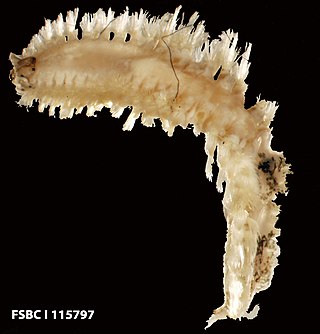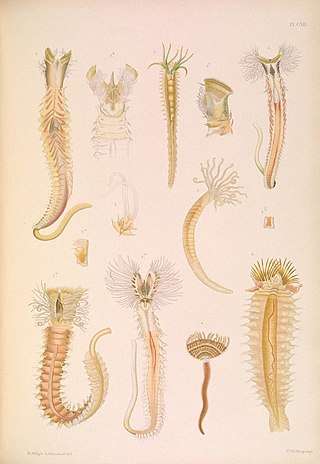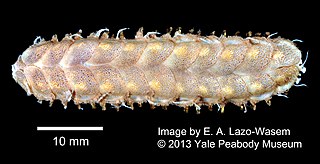
Nereis is a genus of polychaete worms in the family Nereididae. It comprises many species, most of which are marine. Nereis possess setae and parapodia for locomotion and gas exchange. They may have two types of setae, which are found on the parapodia. Acicular setae provide support. Locomotor setae are for crawling, and are the bristles that are visible on the exterior of the Polychaeta. They are cylindrical in shape, found not only in sandy areas, and they are adapted to burrow. They often cling to seagrass (posidonia) or other grass on rocks and sometimes gather in large groups.

The Terebellidae is a marine family of polychaete worms, of which the type taxon is Terebella, described by Carl Linnaeus in his 1767 12th edition of Systema Naturae.

Nephtys is a genus of marine catworms. Some species are halotolerant to a degree in that they can survive in estuaries and estuarine lagoons down to a salinity of 20 psu.

Harmothoe is a genus of marine Polychaete worms belonging to the family Polynoidae. Species of Harmothoe are found world-wide to depths of at least 5,000 m but are more common in shallower water.

Ampharetinae are a subfamily of terebellid "bristle worm". They are the largest subfamily of the Ampharetidae, of which they contain the great majority of the described genera.

Acrocirridae is a family of polychaete worms. Acrocirrids are detritivores, catching falling particles with numerous long prostomial tentacles. There are eight known genera, and at least 21 described species and subspecies within the Acrocirridae. The acrocirrids are primarily benthic (seabed-dwelling) animals, but at least two genera appear to have evolved or adapted to a pelagic (free-swimming) habitat.

Ampharete is a genus of polychaete annelid worms. They have a single, chevron-shaped row of teeth.

Phyllodoce is a genus of polychaete worms, which contains about 200 species. The prostomium bears eyes, two pairs of antennae and a pair of large retractile nuchal organs. The eversible proboscis is clearly divided into two parts.

Diopatra is a genus of polychaete worms in the family Onuphidae.

Amphinomidae, also known as the bristle worms or sea mice, are a family of marine polychaetes, many species of which bear chaetae mineralized with carbonate. The best-known amphinomids are the fireworms, which can cause great pain if their toxin-coated chaetae are touched or trodden on. Their relationship to other polychaete groups is somewhat poorly resolved.

Eulalia is a genus of polychaete worms.

Lepidasthenia is a genus of marine Polychaete worms belonging to the family Polynoidae. Species of Lepidasthenia are found worldwide to depths of about 1200 m but are more common in shallower water.

Eunoe is a genus of marine annelids in the family Polynoidae. The genus includes 48 species which are found world-wide, mostly from depths of 50 m or more.

Lepidonotus is a genus of marine annelids in the family Polynoidae. The genus occurs globally and includes 80 species, usually found in shallow waters down to about 80 metres.
Aglaophamus is a genus of free-burrowing nephtyid worms.

Odontosyllis is a genus of annelids belonging to the family Syllidae.
Prionospio is a genus of annelids belonging to the family Spionidae.
Scolelepis is a genus of annelids belonging to the family Spionidae.
Lumbrineris is a genus of polychaetes belonging to the family Lumbrineridae.

Onuphis is a genus of polychaete belonging to the family Onuphidae.















